A Scion Society of The Baker Street Irregulars
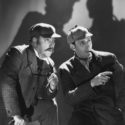
Holmes and Watson in the Great War: The Decorated Duo of Rathbone and Bruce
The noteworthy British actors received military honors
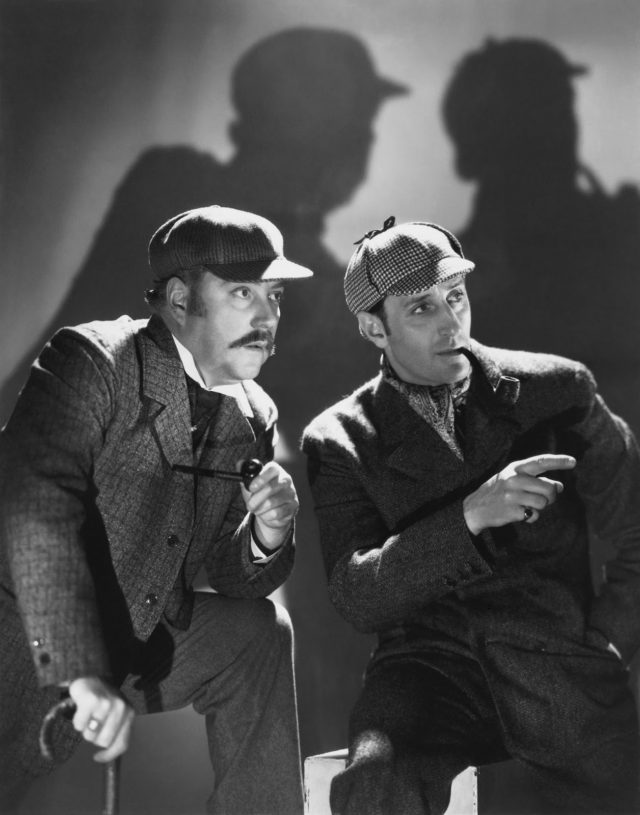
NIGEL BRUCE (left) AND BASIL RATHBONE portrayed Dr. John Watson and detective Sherlock Holmes in the 1939 film adaptation of THE HOUND OF THE BASKERVILLES.
From 1939 to 1946, well-known British actors Basil Rathbone and Nigel Bruce costarred in 15 films and 220 radio programs as Sherlock Holmes and Dr. John Watson, respectively. To many fans, they are the ultimate personification of Sir Arthur Conan Doyle’s famous characters. However, just 25 years earlier, the First World War had engulfed the European continent, and both Rathbone and Bruce fought for King and Country.
Rathbone’s Service
Philip St. John Basil Rathbone was born in South Africa in 1892. His family returned to England in 1897 after the activities of the Reform Movement culminated in the failed Jameson Raid the previous year. He became a naturalized British citizen in 1902.
Rathbone boarded at the Repton School, a notable public institution in Derbyshire, from 1906 to 1910. During his last two years, he joined the junior division of the Officer’s Training Corps(OTC).If war were to occur, the OTC could provide a large pool of men with some military training.
When Britain declared war against Germany on August 4, 1914, Rathbone was hesitant to enlist:
I felt physically sick to my stomach as Is I heard or read of the avalanche of brave men rushing to join “the colors”;and if needs-be to give their lives for God and King and Country…Was I “pigeon-livered” that I felt no such call to duty (or did I, and just refuse to accept it?), that I was pondering how long I could delay “joining up?”. The very idea of soldiering appalled me…
By October of that year, Rathbone had married actress Evelyn Marion Foreman, whom he had met in Stratford-upon-Avon. Their son, Rodion, was born in July 1915. The couple separated after the war, in October 1919, and divorced in 1926.
Rathbone’s younger brother, John, quit school and enlisted in May 1915. Having attained the rank of sergeant major in training, John was commissioned as a captain on June 11, 1915, with the 3rd Battalion of the Dorsetshire Regiment.
As 1915 progressed, the number of army recruits declined. Edward Stanley, the 17th Earl of Derby, was appointed director general of recruiting in October and created a voluntary program called the Group (or Derby) Scheme. Men eligible for military service were encouraged to enlist (or “attest”) by the end of 1915. Rathbone did so on November 13, 1915, and was sent to the Army Reserves the next day. He was assigned to Group 29 in the Derby Scheme, indicating he would be mobilized between March 7 and April 7, 1916.
At the time, recruits could choose the Regiment they wanted to join. Rathbone selected the 14th Battalion, which was part of the London Regiment’s 26 infantry units and the Territorial Force. The latter was designed for Home Defense only, although this changed during the war, and soldiers would have to serve overseas. Given Rathbone’s reluctance to fight, this unit was a natural choice for him.
He was mobilized as a private on March 20, 1916, and started six months of training with the 3rd Line Battalion of the 14th Battalion. Wrote Rathbone of his experience:
I was trained at a camp at Richmond Park, just outside London, to kill Germans… I learned to kill them with a Lewis gun, a rifle, and a bayonet. Of all my training, I loathed bayonet practice most—rushing frantically at a sackful of wet straw and thrusting my bayonet into it, turn the blade sharply so as to increase the size of the wound—then withdraw the cold steel and proceed on to another dummy figure and give it some of the same medicine. The bayonet and the boot. How these images crowd in on me.
On August 29, Rathbone applied for a temporary commission in the Territory Force:
By the grace of God, a hiatus saved me from what looked like being a nearly baptism of fire on the battlefields of northern France. I purposely and with grim intent applied for a commission and was accepted.
Rathbone was transferred on October 5, 1916, and sent to train in Scotland with the No. 10 Officer’s Cadet Battalion. He received his commission on January 25, 1917, as a second lieutenant in the Second Line Battalion of the 10th Battalion, Liverpool Regiment. This unit was attached to the 57th Division and, as a member of the Territorial Force, had Home Defense duties. (Rathbone had asked to be appointed to this unit when he applied for a commission.)
The following month, Rathbone’s unit shipped out to join the fighting in France. However, he was not among them, as he contracted measles in February 1917. After spending a week at a military hospital, he was sent back to London to recuperate at home with his brother, John, who suffered wounds to his chest and right lung during the Battle of the Somme in July 1916. A medical board convened on March 5, 1917, determined that Rathbone had recovered and was fit for general service overseas. During his training and recuperation, he realized the gravitas of his duties:
As Private Rathbone I cannot be certain what might have been my fate as a man, “pigeon-livered” or not. But as Second Lieutenant Rathbone I was no longer in a position to consider myself. I was in command of a platoon of men who were almost completely dependent on me in every possible way, and who looked to me for example and leadership, whatever the circumstances.
On May 23, 1917, he arrived for duty and joined B Company, stationed near the French village of Erquinghem-Lys. Within a week, the unit would occupy the trenches for 10 days in the Bois-Grenier sector, where Rathbone got his first taste of warfare. For the next several months, B Company rotated in and out of the trenches. In October 1917, the Battalion relocated to Ypres, Belgium, repeating the cycle of training and then returning to serve in the trenches.
The Germans launched their Spring Offensive on March 21, 1918. The British suffered a large number of casualties, resulting in a reorganization of the troops. Rathbone’s unit, the Second Line Battalion, was disbanded and transferred to the 1st Line Battalion of the King’s Liverpool Regiment, with which he remained for the duration of his military service.
By early 1918, John Rathbone was healthy enough to return to the front lines with the Dorsetshire Regiment. He was killed in action on June 4, 1918.
As a patrols officer, Basil Rathbone led nighttime forays into the no-man’s-land between the British and German trenches to gather information about enemy activities. Shortly after his brother’s death, he convinced his superiors to allow him to scout enemy positions during daylight hours rather than at night, a very risky endeavor. Was he experiencing feelings of guilt or great loss over his brother’s death, or was he seeking vengeance?
Rathbone described these dangerous daytime missions in a January 11,1957, television interview with newsman Edward R. Murrow. During one foray on July 26, 1918, Rathbone was spotted by a German sentry. He defended himself by firing his revolver twice and killing the soldier. This alerted the German troops, and they began firing machine guns at Rathbone and his men, who scrambled to get back to their trenches.
Rathbone’s commanding officers praised him and the daylight patrols, which continued into August. The information gleaned was deemed invaluable. (The battalion’s war diaries show that on July 26, Rathbone was a second lieutenant; by August 9, he was a lieutenant.)
Rathbone was awarded the Military Cross for bravery on September 9, 1918, and his citation was published in a supplement to the London Gazette on November 5, 1918. He was demobilized on April 22, 1919, at Harrowby Camp in Grantham. Shortly thereafter, he relinquished his commission and returned to acting.
Bruce’s Service
William Nigel Ernle Bruce was born in Mexico in 1895. His family returned to England in August 1896 after the death of his oldest sister, Grace, the previous year. He was educated at the Abingdon School in Berkshire and, much like Rathbone, joined the OTC’s junior division. Bruce enlisted for a four year tour of duty on August 4, 1914, the day Britain declared war against Germany. He was mobilized the following day with the Honourable Artillery Company (HAC).
For the next several weeks, the HAC and other units underwent accelerated training. King George V inspected the 1,000 strong HAC Battalion on September 12 as it marched from Armoury House to the St. Pancras train station. Less than a week later, on September 18, Bruce and the rest of the HAC boarded the SS Westmeath; two days later, they headed for St. Nazaire, France.
Upon arriving in France, the battalion continued to train. Gradually eased into the front lines, Bruce and his fellow soldiers encountered their first battle by November 27. The king, along with the Prince of Wales, inspected the troops on December 3. One of Bruce’s treasured keepsakes was a Christmas card signed by George V and Queen Mary, who sent holiday wishes to every member of the Expeditionary Force that year.
By January 2, 1915, the battalion was in Locre, a small Belgian village located six miles southwest of Ypres. The HAC’s war diary entry for January 6 noted, “Captain Newton killed [at] 9am and 3 men wounded by enfilade fire of machine gun in F.1. trench.” One of those three men was Private Nigel Bruce, who suffered gunshot wounds to his right femur, resulting in a compound fracture. He was taken by stretcher to a first-aid post and then transported by the 7th Field Ambulance at Locreto the 8th Casualty Clearing Station in Bailleil. Because his wounds were serious, Bruce was sent to Boulogne and the 13th General Hospital. On January 25, he was returned to England on the Hospital Ship St.Andrew.
Bruce, in a bit of canonical irony, spent the next 10 months recuperating from his injuries at St. Bartholomew’s Hospital in London. On December 8, 1915, he was “discharged in con sequence of being no longer physically fit for war service.” (Because of his wounds, Bruce’s right leg was shorter by 11⁄4 inches.) All told, he served in France for 130 days.
On July 19, 1916, Bruce applied for a temporary commission in a “Home garrison battalion,” and, following a medical exam at St. Bart’s, was determined to be “fit for Military Service (light duty).” He was recommended to become a second lieutenant with the 2nd Garrison Battalion Northamptonshire Regiment. However, his application was rejected on August 17, as he did not have previous experience as a military officer. (It was noted that he would be accepted to an Officer Cadet Unit, should one be formed.)
On October 10, 1916, Bruce once again applied for a commission. A medical exam revealed that he had “Seven scars above right knee. Scar middle left femur.” Nevertheless, two days later,he was off to the No. 2 Officers Cadet Battalion, Pembroke College, Cambridge. He was granted a temporary commission on December 15, 1916, in the 10th Battalion, Somerset Light Infantry. A January 9, 1917, “joining certificate” in Bruce’s military records indicates that he was “unable to join for duty owing to being in Hospital owing to his wound having to be treated.” An undated letter from Bruce, attached to that certificate, noted that he had undergone 11 operations for his injuries.
A June 27, 1917, entry in Bruce’s file states, “Evidently he has never joined, being in hospital owing to wounds sustained by him whilst serving as a private with the H.A.C.” On July 6, a medical board found him fit for light duty only. After a brief leave, he joined the 14th Battalion King’s Own Yorkshire Light Infantry on July 29.
Bruce’s stay with the 14th Battalion was short. On August 11, he joined the Garrison Officer Cadet Battalion, Westcott House, Cambridge as an “officer instructor.” An October 8 report from the medical board shows him serving with the 10th Battalion, Somerset Light Infantry.
From January 14 to February 9, 1918, Bruce attended an Instructors’ Course Senior Officers’ School. After completing the program, he returned to the 10th Battalion with his new rank of lieutenant. In a report by his commanding officer, Bruce was found to be “cheerful, energetic and very keen to learn. Thinks for himself and has imagination.”
On August 7, 1918, Bruce was struck in the head by a cricket bat “while on a week’s leave and sustained a fracture of the left malar bone.” This injury kept him sidelined for 10 weeks. On September 24, Bruce was determined to be “Fit Category A,” which would allow him to be considered for overseas duty.
Bruce applied for a permanent commission in the British Army after the war’s end. His September 15, 1919, application shows that he was serving in Belfast, Ireland, with the 3rd Battalion, Somerset Light Infantry. Though he hoped to be a suitable candidate for a permanent commission, he was not accepted.
While serving with the 1st Battalion, Somerset Light Infantry in Dublin, Bruce was demobilized in January 1920. He relinquished his commission on September 1, 1921, retaining his rank of lieutenant.
In his unpublished memoirs, Games, Gossip and Greasepaint, Bruce described his wounds and his work:
We made three Sherlock Holmes pictures during 1944. They were called “The Scarlet Claw”, “The Pearl of Death” and “The House of Fear”. When I completed “The House of Fear” I had made my 50th picture in Hollywood.
We spent much of the beginning of 1945 at “The Lair”, and I only went into town for the radio program on Friday. For the first 12 weeks of the year I was laid off by the studio. My new contract now called for $1,150.00 a week. As the studio had notified me that I would be laid off for a period of four weeks, I arranged to have another operation on my legs. The wounded one was playing up again and I was suffering varicose veins in both of them.
The radio program ran from January 1st to May 28th and I only missed one performance due to the operation. On the program following it, Edna Best very kindly arranged for me to lie on a sofa in the studio and, except for being very tired after the show, I was none the worst for it.
On May 28th, we finished our radio program and went off the air for the summer months. We had been on the air continuously since April 1943, and out of 111 consecutive programs I had only missed two—one when I went to Canada to see Pauline (his daughter), and one during my recent operation.
Unfortunately, no recordings of The New Adventures of Sherlock Holmes radio programs survive from the first three months of 1945, so it is not clear which episode Bruce missed because of his operation.
Rathbone & Bruce’s Military Decorations
Each of the actors earned three military honors. Rathbone received the Military Cross, while Bruce was presented the 1914 Star. Both received the British War Medal and the Victory Medal, although Rathbone’s Victory Medal also bore an oak leaf. (Rathbone’s brother, John, was awarded the 1914-15 Star, the British War Medal and the Victory Medal, which were presented to their father.)
The Military Cross
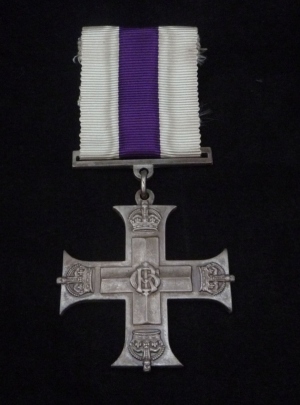
THE MILITARY CROSS, introduced in December 1914 to recognize “distinguished and meritorious service,” was, at the time, presented only to officers of the British and Imperial armed forces.
The Military Cross was created on December 28, 1914, to recognize “distinguished and meritorious service.” At the time, only commissioned officers and warrant officers of the British and Imperial forces were eligible to receive the honor. (All ranks became eligible in 1993.)
The ornamental silver cross has straight arms terminating in broad finials, suspended from a plain bar. The uniface medal measures 46 x 44 mm and features four imperial crowns and the royal cypher of King George V (“GR”). Later, some recipients had their names engraved on the blank reverse at their own expense. The ribbon is 32 mm wide and consists of three equal vertical stripes—two white and one purple. Slightly more than 41,200 medals were awarded during George V’s reign. Rathbone, as a recipient of this honor, had the option of using the letters “MC” (for “Military Cross”) after his name.
The 1914 Star
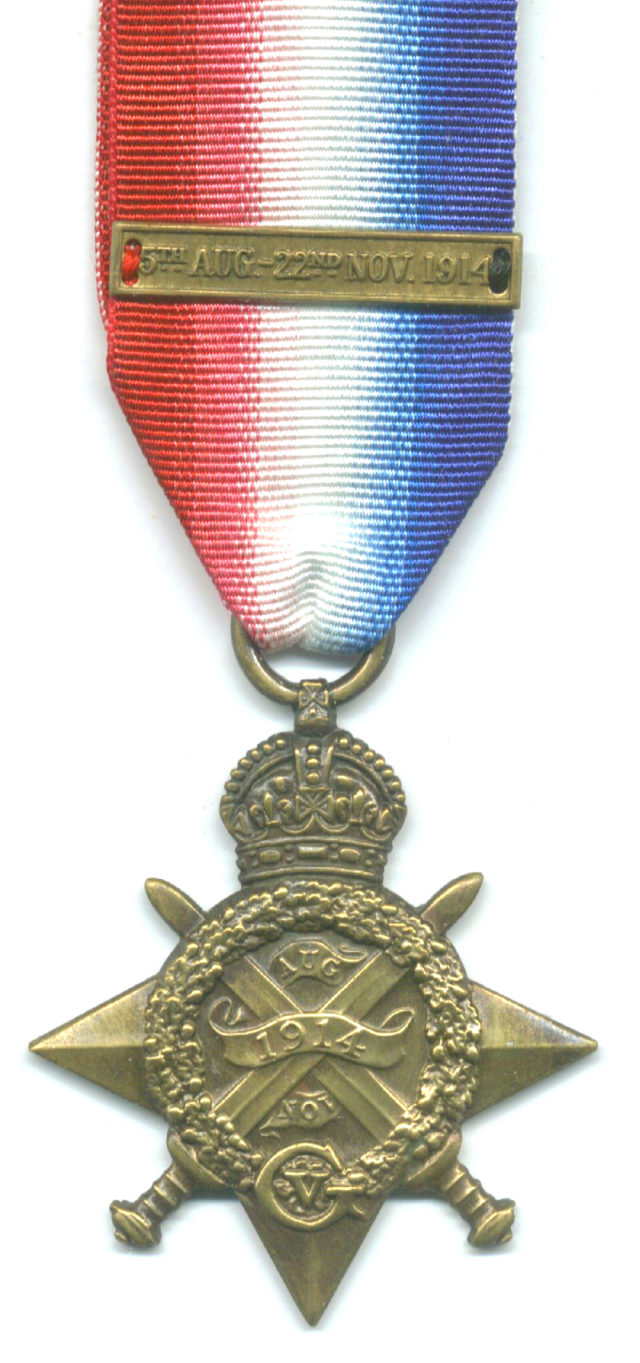 THIS 1914 BRONZE STAR with a bar-shaped adornment on the ribbon was presented to soldiers who came under enemy fire between August 5 and November 22, 1914.
THIS 1914 BRONZE STAR with a bar-shaped adornment on the ribbon was presented to soldiers who came under enemy fire between August 5 and November 22, 1914.
By virtue of his arrival in France on September 20, 1914, Bruce earned his first military decoration. The 1914 Star was authorized for presentation to members of the British Expeditionary Forces who served in either Belgium or France between August 5 and November 22, 1914. These dates coincide with Britain’s declaration of war against the Central Powers and the conclusion of the First Battle of Ypres.
Measuring 50 x 44 mm, the bronze medal resembles a four pointed star, topped off with the royal crown. The medal hangs from a 32 mm wide ribbon, which has three equal bands of red, white and blue, mimicking the colors of the Union Jack, the flag of the United Kingdom.
Adorning the obverse are two crossed swords under an oak leaf wreath, with a scroll inscribed AUG 1914 NOV. At the bottom of the wreath is the king’s “GR” cypher. The reverse of the medal is plain and often is engraved with number, rank, name and unit of the recipient.
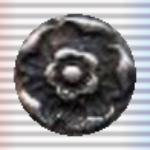
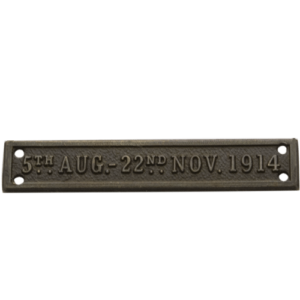
Many of the 1914 Stars can be found with a rosette and/or a bar that reads 5TH AUG.– 22ND NOV. 1914. These medals were presented to soldiers who had come under enemy fire during the stated period. The 31 x 5 mm clasp was sewn on to the ribbon.If the recipient was wearing only the ribbon bar,the rosette pin would be attached to the bar. The clasps and roses were not automatically issued and had to be requested by the recipient from the War Medal Office.
This medal is similar in appearance to the 1914-15 Star, which was given for service between August 5, 1914, and December 31, 1915. A recipient could earn one or the other but not both. (The scroll reads 1914-15, rather than AUG. 1914, as on the first medal.)
Neither star was presented individually; each was accompanied by the British War Medal and the British Victory Medal. By 1923, more than 360,000 1914 Stars had been awarded; approximately 145,000 of them had clasps, including the one presented to Nigel Bruce.
The British War Medal
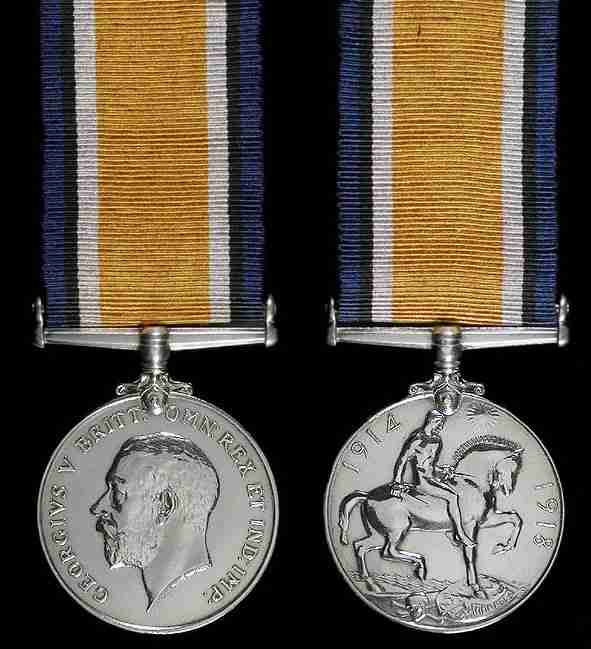
THE BRITISH WAR MEDAL bears an image of King George V. The recipient’s service number, rank, name and unit often were engraved on the edge.
The British War Medal was created on July 26, 1919, to recognize those who rendered service between August 5, 1914, and the armistice of November 11, 1918. Recipients were required to have completed 28 days of mobilized service in an active theater of war, which both Rathbone and Bruce had done.
The 36 mm silver medal has a straight clasp (without swivel), suspended from a 32 mm watered silk ribbon bearing white, black, gold and royal-blue stripes. The recipient’s name, rank, service number and unit were impressed on the medal’s bottom edge.
The obverse of the medal features King George V facing left, encircled by the inscription GEORGIVS V BRITT: OMN: REX ET IND: IMP:. The reverse features St. George on horseback and armed with a short sword. The horse is trampling the Prussian eagle shield; a skull and crossbones appears below in the foreground. Behind are ocean waves and the rising sun of Victory. The years 1914 and 1918 appear at the left and right, respectively. The service number, rank, name and unit of the recipient could be engraved on the edge. All told, more than 4.7 million British War Medals were awarded by 1923.
The British Victory Medal

THE BRITISH VICTORY MEDAL, released in September 1919, was awarded in tandem with the War Medal (above)
During negotiations for the Treaty of Versailles, each of the 14 victorious Allied Forces issued a medal commemorating their triumph with a personification of Winged Victory. Introduced on September 1, 1919, the 36 mm British Victory medal was struck in copper and suspended from a 39 mm-wide ribbon with a “double rainbow” pattern. The obverse bears an image of Victory at the center of the Queen Victoria Memorial in London. The reverse features the legend THE GREAT / WAR / FOR CIVILISATION / 1914–1919 with in a laurel wreath. The service number,rank, name and unit of the recipient often were engraved on the edge of the medal.

An oak leaf can be found on some ribbons, indicating the medal recipient had been recognized for gallant or meritorious action in the face of the enemy. Having been awarded the Military Cross, Rathbone was eligible for the oak leaf on his decoration. By 1923, nearly 2.6 million Victory Medals had been bestowed.
British Medal Index Cards
Toward the end of World War I, the Army Medal Office began to assemble a database of medal recipients. Index cards were used to record the various honors presented to soldiers.
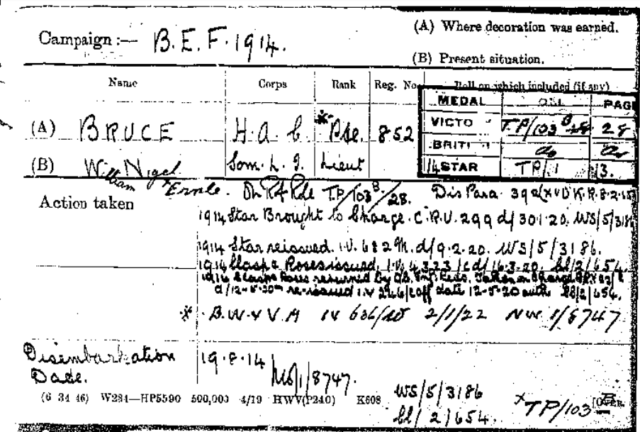
Nigel Bruce submitted his claim for the 1914 Star in November 1919, and the medal was issued to him on January 30, 1920. The clasp and rosette were sent later on March 6, but Bruce had relocated, so both mailings were returned to the Medal Office. The items finally arrived on May 7. Nearly two years passed before he received his British War and Victory Medals on January 2, 1922.
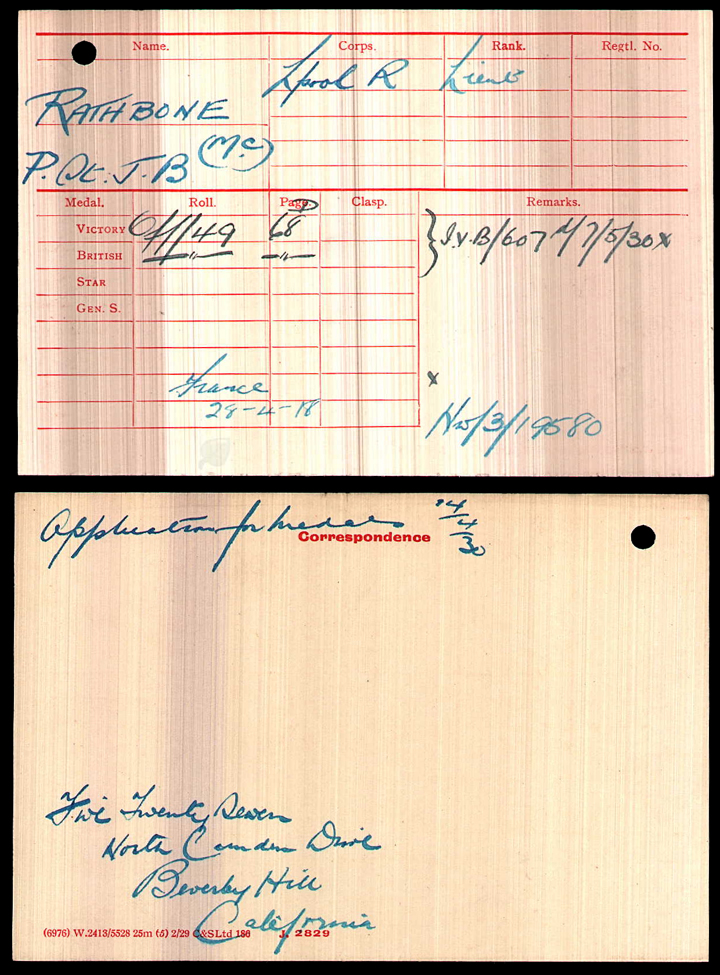
Basil Rathbone apparently was in no rush to receive his medals, as he waited until 1930 to file his claim. Given the “MC” notation on his card, he likely received the oak leaf clasp for his Military Cross.
About the time that many British soldiers were receiving their medals, two comic strips were particularly popular—Pip, Squeak and Wilfred and Mutt & Jeff—and these became associated with the honors. Pip the Penguin, Squeak the Dog and Wilfred the Rabbit appeared in the Daily Mirror, and their names came to represent the 1914 or 1914-15 Star, the British War Medal and the British Victory Medal, respectively. (Bruce could claim he had this set.) Soldiers like Rathbone, who earned the pair of honors consisting of the British War and Victory Medals, referred to their decorations as Mutt and Jeff.
Rathbone and Bruce shared the experience of war, the horror of combat, the pain of injury and the anguish of personal loss. Now we can doubly respect them for their dramatic talent and brave military service.
Acknowledgments
The author would like to thank independent researcher Robert Clark and The National Archives of the United Kingdom for their assistance in the preparation of this article.
SOURCES
Giblin, Harold. Bravest of Hearts: The Biography of a Battalion—The Liverpool Scottish in the Great War. Liverpool: Winordie Publications, 2000.
Jerry Haendiges Vintage Radio Logs. “Sherlock Holmes.” .
national archives.gov.uk.
“Nigel Bruce Dies at 58: Stage and Screen Actor.” New York Herald-Tribune (October 9, 1953).
Rathbone, Basil. In and Out of Character. Garden City, NY: Doubleday, 1962.
Read, Fergus. “British First World War Service Medals.” iwm.org.uk/history/first-worldwar-service-medals.
Risk, James C. “British Orders and Decorations.” Numismatic Notes and Monographs, 106 (1945).
TSorenson, M. “Medals and Decorations.” The Numismatist (July 1923).
Utechin, Nicholas. “Extracts from the Unpublished Autobiography of Nigel Bruce.” Sherlock Holmes Journal (Winter 1988).
Van Emden, Richard, and Victor Piuk. Famous: 1914-1918. South Yorkshire: Pen and Sword, 2010.
Walker, Major G. Goold, D.S.O., M.C. The Honourable Artillery Company 1914-1919. London: Seeley, Service & Co., Ltd., 1930.
This article was originally published in the February 2019 edition of The Numismatist, official publication of the American Numismatic Association, and was adapted from “Holmes and Watson in the Great War: The Decorated Duo of Rathbone and Bruce” by Greg D. Ruby, published in TRENCHES: THE WAR SERVICE OF SHERLOCK HOLMES (The Baker Street Irregulars Manuscript Series, 2017), which can be purchased from the BSI Press.
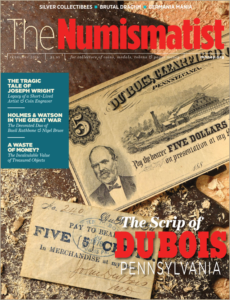
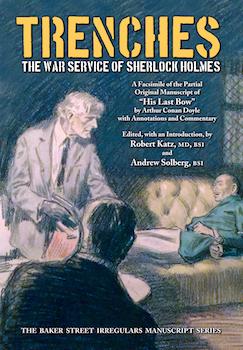

Fifteen films as Holmes and Watson? Are you counting “Crazy House?” I would argue that they did not “star” in that one.